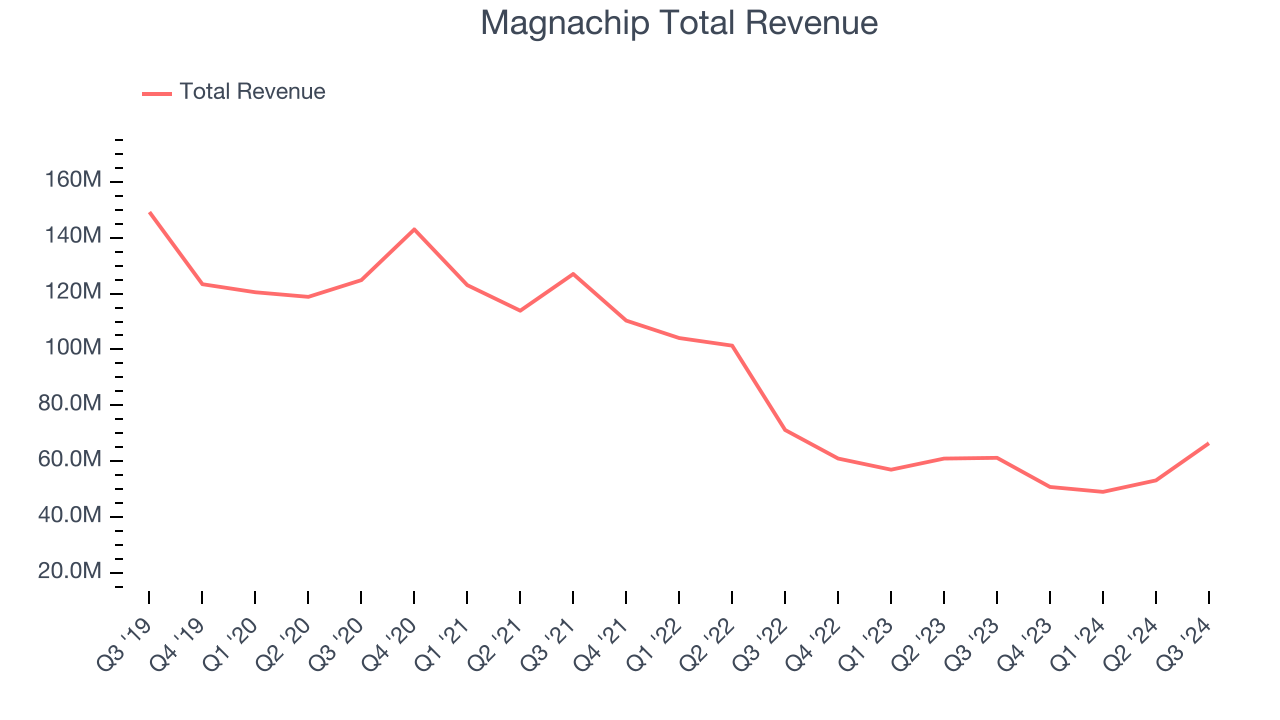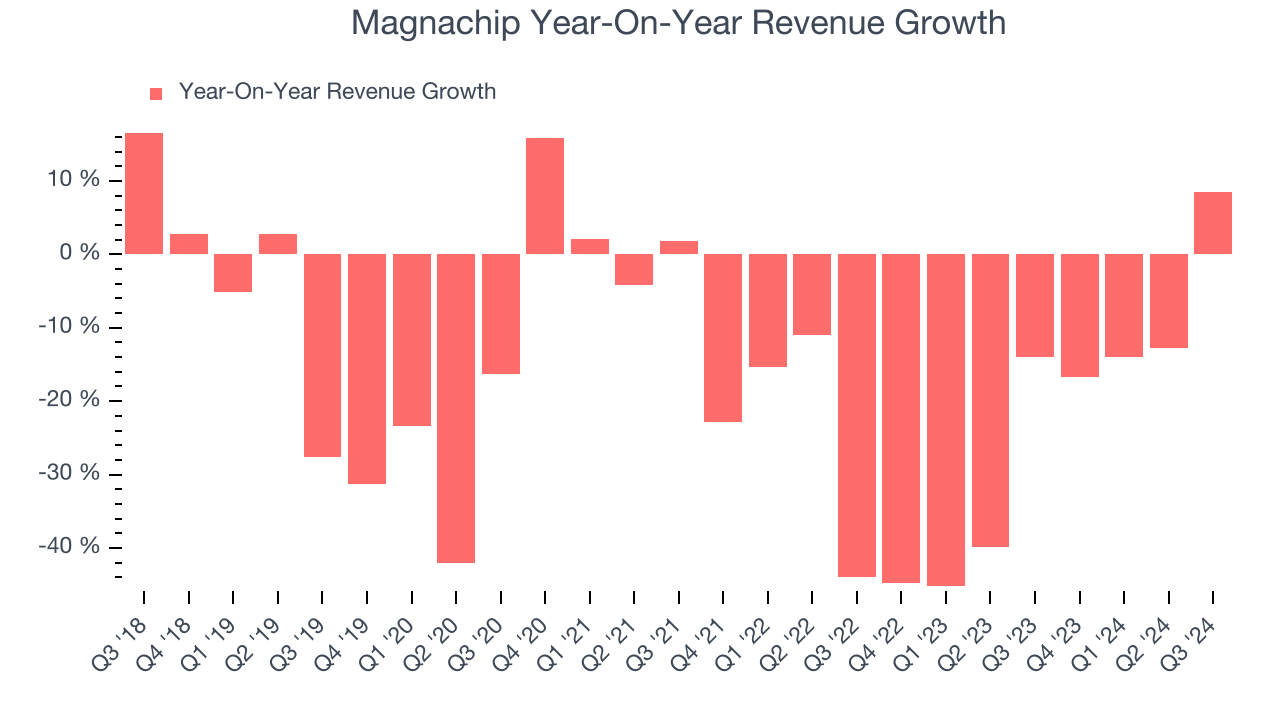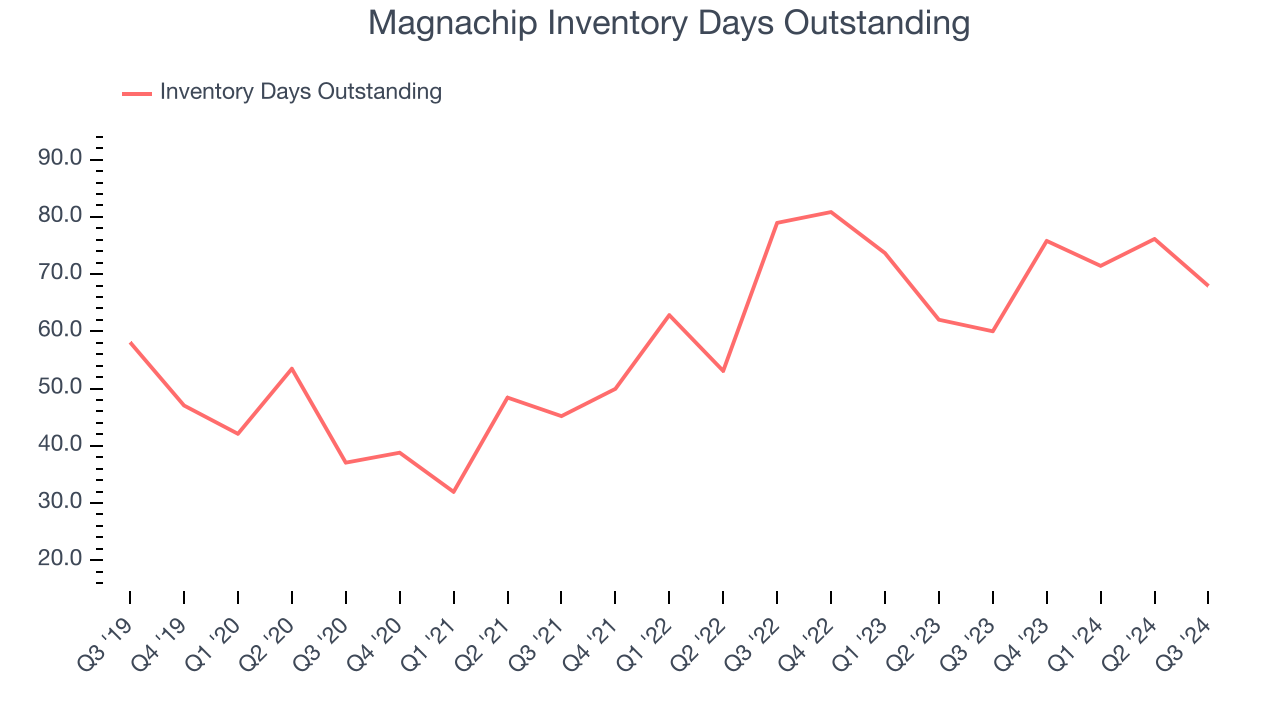![]()
Semiconductor manufacturer Magnachip Semiconductor (NYSE:MX) beat Wall Street’s revenue expectations in Q3 CY2024, with sales up 8.5% year on year to $66.46 million. The company also expects next quarter’s revenue to be around $61.5 million, slightly above analysts’ estimates. Its non-GAAP loss of $0.34 per share was 82.1% below analysts’ consensus estimates.
Is now the time to buy Magnachip? Find out by accessing our full research report, it’s free.
Magnachip (MX) Q3 CY2024 Highlights:
- Revenue: $66.46 million vs analyst estimates of $64.03 million (3.8% beat)
- Adjusted EPS: -$0.34 vs analyst estimates of -$0.19
- EBITDA: -$4.95 million vs analyst estimates of -$3.1 million (59.6% miss)
- Revenue Guidance for Q4 CY2024 is $61.5 million at the midpoint, above analyst estimates of $61 million
- Consolidated revenue flattish, as raised vs prior expectation of flattish-to-slightly down
- Gross Margin (GAAP): 27.2%, up from 23.6% in the same quarter last year
- Inventory Days Outstanding: 68, down from 76 in the previous quarter
- Operating Margin: -16.6%, down from -15.1% in the same quarter last year
- EBITDA Margin: -7.4%, down from -4.5% in the same quarter last year
- Free Cash Flow was -$15.51 million, down from $973,000 in the same quarter last year
- Market Capitalization: $168.6 million
YJ Kim, Magnachip’s CEO, commented, “Our Q3 revenue was at the high-end of guidance driven by broad-based growth in our Standard Product businesses, which is comprised of our MSS and PAS businesses. Standard Product revenue increased 25.9% sequentially and 24% year-over-year. Our discrete Power business benefited from leaner inventory in distribution channels as well as new product designs wins resulting in better-than-seasonal growth. In MSS, the strong sequential growth was due to increased demand for products targeted for China smartphone OEMs, automotive displays, and OLED IT.”
Company Overview
With its technology found in common consumer electronics such as TVs and smartphones, Magnachip Semiconductor (NYSE:MX) is a provider of analog and mixed-signal semiconductors.
Analog Semiconductors
Demand for analog chips is generally linked to the overall level of economic growth, as analog chips serve as the building blocks of most electronic goods and equipment. Unlike digital chip designers, analog chip makers tend to produce the majority of their own chips, as analog chip production does not require expensive leading edge nodes. Less dependent on major secular growth drivers, analog product cycles are much longer, often 5-7 years.
Sales Growth
Reviewing a company’s long-term performance can reveal insights into its business quality. Any business can have short-term success, but a top-tier one sustains growth for years. Magnachip’s demand was weak over the last five years as its sales fell by 20.5% annually, a rough starting point for our analysis. Semiconductors are a cyclical industry, and long-term investors should be prepared for periods of high growth followed by periods of revenue contractions.

Long-term growth is the most important, but recency is necessary for semiconductors because of Moore's Law, which suggests the pace of technological innovation is so high that yesterday's hit new product could be obsolete today. Magnachip’s recent history shows its demand has stayed suppressed as its revenue has declined by 24.7% annually over the last two years. 
This quarter, Magnachip reported year-on-year revenue growth of 8.5%, and its $66.46 million of revenue exceeded Wall Street’s estimates by 3.8%. Management is currently guiding for a 21% year-on-year increase next quarter.
Looking further ahead, sell-side analysts expect revenue to grow 18.8% over the next 12 months, an improvement versus the last two years. This projection is admirable and illustrates the market thinks its newer products and services will fuel higher growth rates.
Unless you’ve been living under a rock, it should be obvious by now that generative AI is going to have a huge impact on how large corporations do business. While Nvidia and AMD are trading close to all-time highs, we prefer a lesser-known (but still profitable) semiconductor stock benefitting from the rise of AI. Click here to access our free report on our favorite semiconductor growth story.
Product Demand & Outstanding Inventory
Days Inventory Outstanding (DIO) is an important metric for chipmakers, as it reflects a business’ capital intensity and the cyclical nature of semiconductor supply and demand. In a tight supply environment, inventories tend to be stable, allowing chipmakers to exert pricing power. Steadily increasing DIO can be a warning sign that demand is weak, and if inventories continue to rise, the company may have to downsize production.

This quarter, Magnachip’s DIO came in at 68, which is 10 days above its five-year average. These numbers suggest that despite the recent decrease, the company’s inventory levels are higher than what we’ve seen in the past.
Key Takeaways from Magnachip’s Q3 Results
We were impressed by Magnachip’s strong improvement in inventory levels. We were also glad its gross margin improved. Looking ahead, the company raised its full year revenue guidance, now expecting flattish revenue year on year compared to the previous expectation of flattish to slightly down. Gross margin guidance was also raised. On the other hand, its EPS missed analysts’ expectations and its EBITDA fell short of Wall Street’s estimates. Overall, this was a mixed quarter with good guidance lifting shares. The stock traded up 2.7% to $4.60 immediately following the results.
Big picture, is Magnachip a buy here and now? When making that decision, it’s important to consider its valuation, business qualities, as well as what has happened in the latest quarter. We cover that in our actionable full research report which you can read here, it’s free.













